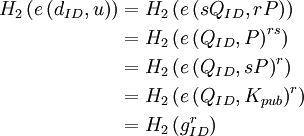Boneh–Franklin scheme
The Boneh/Franklin scheme is an Identity based encryption system proposed by Dan Boneh and Matthew K. Franklin in 2001.[1] This article refers to the protocol version called BasicIdent. It is an application of pairings (Weil pairing) over elliptic curves and finite fields.
Groups and parameters
As the scheme bases upon pairings, all computations are performed in two groups  and
and  :
:
For  , let
, let  be prime,
be prime,  and consider the elliptic curve
and consider the elliptic curve  over
over  . Note that this curve is not singular as
. Note that this curve is not singular as  only equals
only equals  for the case
for the case  which is excluded by the additional constraint.
which is excluded by the additional constraint.
Let  be a prime factor of
be a prime factor of  (which is the order of
(which is the order of  ) and find a point
) and find a point  of order
of order  .
.  is the set of points generated by
is the set of points generated by  :
: 
 is the subgroup of order
is the subgroup of order  of
of  . We do not need to construct this group explicitly (this is done by the pairing) and thus don't have to find a generator.
. We do not need to construct this group explicitly (this is done by the pairing) and thus don't have to find a generator.
Protocol description
Setup
The Private Key Generator (PKG) chooses:
- the public groups
 (with generator
(with generator  ) and
) and  as stated above, with the size of
as stated above, with the size of  depending on security parameter
depending on security parameter  ,
, - the corresponding pairing
 ,
, - a random private master-key
 ,
, - a public key
 ,
, - a public hash function
 ,
, - a public hash function
 for some fixed
for some fixed  and
and - the message space and the cipher space

Extract
To create the public key for  , the PKG computes
, the PKG computes
-
 and
and - the private key
 which is given to the user.
which is given to the user.
Encrypt
Given  , the ciphertext
, the ciphertext  is obtained as follows:
is obtained as follows:
-
 ,
, - choose random
 ,
, - compute
 and
and - set
 .
.
Note that  is the PKG's public key and thus independent of the recipient's ID.
is the PKG's public key and thus independent of the recipient's ID.
Decrypt
Given  , the plaintext can be retrieved using the private key:
, the plaintext can be retrieved using the private key:

Correctness
The primary step in both en- and decryption is to employ the pairing and  to generate a mask (like a symmetric key) that is xor'ed with the plaintext. So in order to verify correctness of the protocol, one has to verify that an honest sender and recipient end up with the same values here.
to generate a mask (like a symmetric key) that is xor'ed with the plaintext. So in order to verify correctness of the protocol, one has to verify that an honest sender and recipient end up with the same values here.
The encrypting entity uses  , while for decryption,
, while for decryption,  is applied. Due to the properties of pairings, it follows that:
is applied. Due to the properties of pairings, it follows that:

Security
The security of the scheme depends on the hardness of the Bilinear Diffie-Hellman Problem (BDH) for the groups used. It has been proved that in a random-oracle model, the protocol is semantically secure under the BDH assumption.
Improvements
BasicIdent is not chosen ciphertext secure. However, there is a universal transformation method due to Fujisaki and Okamoto that allows for conversion to a scheme having this property called FullIdent.
References
- ↑ Dan Boneh, Matthew K. Franklin, Identity-Based Encryption from the Weil Pairing Advances in Cryptology - Proceedings of CRYPTO 2001 (2001)
External links
- Seminar 'Cryptography and Security in Banking'/'Alternative Cryptology', Ruhr University Bochum
- P(airing) B(ased) C(ryptography) library, designed by Ben Lynn et al.